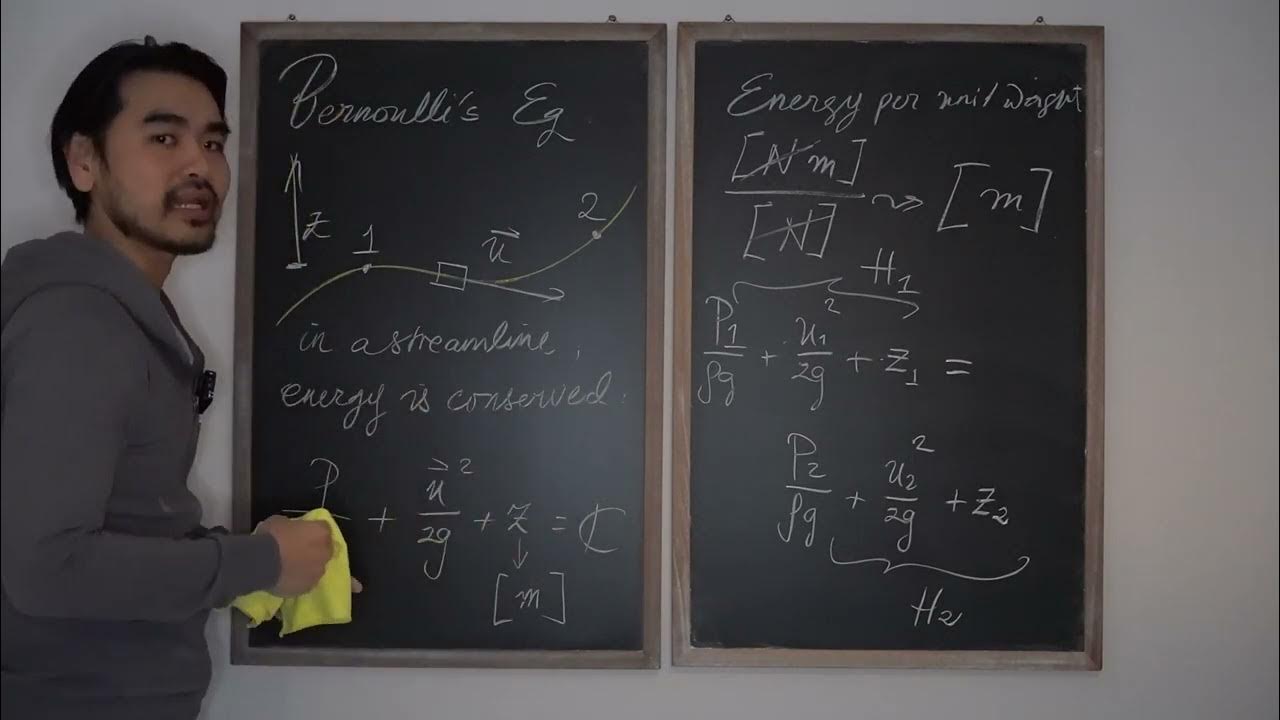Mekanika Fluida FM01 (Lecture3: 8/8). Energy Line & Hydraulic Grade Line
Summary
TLDRThis video explains Bernoulli's equation and its application to fluid mechanics, emphasizing the conservation of energy in fluid flow through pipes. The speaker illustrates how Bernoulli's equation can be visualized with instruments like Pito Cups, showing the relationship between pressure, velocity, and height. The concept of total head, including static, dynamic, and piezometric heads, is explored, with a focus on how fluid velocity and pressure change in pipes with varying cross-sectional areas. The speaker also introduces the hydraulic gradient and discusses how energy is conserved throughout the system, providing a clear, visual understanding of complex fluid dynamics concepts.
Takeaways
- 😀 Bernoulli's equation can be understood visually through concepts like total head, static head, and dynamic head.
- 😀 The total energy in a fluid system remains constant along a streamline, as illustrated by Bernoulli's principle.
- 😀 Bernoulli’s equation is represented by a formula that includes pressure (P), velocity (V), and height (Z), and it highlights the conservation of energy.
- 😀 Streamlines can be visualized as representing the flow of energy in a fluid, where different points along the streamline have constant total energy.
- 😀 The principle of conservation of energy states that total energy at point one will be the same as total energy at point two, assuming no energy losses.
- 😀 Static pressure and dynamic pressure are components of Bernoulli's equation, with dynamic pressure increasing as velocity increases.
- 😀 The speed of the fluid increases when the cross-sectional area of the pipe decreases, as explained by the continuity equation.
- 😀 The velocity at point two in a narrowing pipe increases, causing a decrease in static pressure to keep the total energy constant.
- 😀 The hydraulic gradient line represents the change in pressure head as fluid moves through a pipe with varying dimensions.
- 😀 Bernoulli’s principle can be applied to complex problems in fluid mechanics, such as in varying pipe diameters and fluid flow rates.
Q & A
What is the main focus of the lecture?
-The main focus of the lecture is on visualizing fluid mechanics, specifically Bernoulli’s equation, and how energy is conserved in a flowing fluid system.
How does Bernoulli's equation help understand fluid flow?
-Bernoulli's equation helps explain the conservation of energy along a streamline, combining static head, dynamic head, and elevation head, which remains constant throughout the fluid flow.
What are the three types of heads discussed in the lecture?
-The three types of heads discussed are static head (P/ρg), dynamic head (V²/2g), and elevation head (z), all contributing to the total energy of the fluid system.
How does the cross-sectional area of a pipe affect fluid flow?
-As the cross-sectional area of a pipe decreases, the fluid velocity increases and the pressure decreases, which is explained by Bernoulli's principle.
What is the significance of a piezometer in fluid mechanics?
-A piezometer is used to measure the pressure head at a specific point in the fluid, helping visualize pressure changes in the system.
What is the role of the Pitot tube in the lecture?
-The Pitot tube is used to measure the velocity head at specific points in the fluid, helping to determine the flow speed and energy distribution.
What does the total head in Bernoulli's equation represent?
-The total head in Bernoulli’s equation represents the sum of the static head, dynamic head, and elevation head, all of which contribute to the total energy in the system.
Why is the hydraulic gradient line important in fluid flow analysis?
-The hydraulic gradient line represents the distribution of total energy per unit weight of the fluid, showing how energy changes as fluid moves through a pipe with varying cross-sectional areas.
How does Bernoulli’s principle explain the behavior of fluid speed and pressure in a pipe with changing dimensions?
-Bernoulli's principle explains that as the cross-sectional area of the pipe decreases, the speed of the fluid increases, which causes a corresponding decrease in pressure to maintain constant total energy.
What assumption is made when applying Bernoulli's equation in the lecture?
-The assumption made is that the fluid is incompressible, and that external forces and changes in the fluid’s density are negligible.
Outlines

This section is available to paid users only. Please upgrade to access this part.
Upgrade NowMindmap

This section is available to paid users only. Please upgrade to access this part.
Upgrade NowKeywords

This section is available to paid users only. Please upgrade to access this part.
Upgrade NowHighlights

This section is available to paid users only. Please upgrade to access this part.
Upgrade NowTranscripts

This section is available to paid users only. Please upgrade to access this part.
Upgrade Now5.0 / 5 (0 votes)





